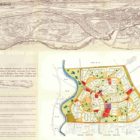Then & Now
St. Albert’s Mayors
September, 2017
It’s election season in St. Albert, and on October 16, our city will be choosing a brand new mayor. To date, St. Albert has had 21 mayors, each a link in the chain of leadership that’s made our city what it is. Before you vote this month, take a look back, and see what kind of legacy the winner will be inheriting.
1904 to 1919
When St. Albert officially incorporated as a town, Cheri Hebert had the honour of being elected the very first mayor. Hebert’s council included Fleuri Perron and Lucien Boudreau, who would later hold the post of mayor during St. Albert’s formative years, in 1908 and 1909 respectively. While their names are mostly remembered as roads here in town, all three men were prominent business owners and instrumental in attracting businesses and setting St. Albert on a path of growth.
Herbert Dawson (elected 1910) and Leon Levasseur (elected 1911) continued the tradition of improving the town’s business interests and attracting more institutions to St. Albert. J. Arthur Giroux (elected 1912) was St. Albert’s first doctor in addition to serving as mayor, and he brought St. Albert through the First World War. Having a doctor as mayor didn’t spare St. Albert from the Spanish Flu, which erupted towards the end of the war. Between the deaths, injuries and epidemic that the war brought home, St. Albert’s economy suffered. Alex Perron (elected 1918), the son of Fleuri, would try to remedy the economic situation during his brief stay in office, but to no avail. St. Albert would take many years to recover.
1919 to 1943
The mayoral career of Michael Hogan (elected 1919) was, in some ways, cursed from the start. The financial hardships that followed the war went from bad to worse as a result of the Great Depression. Hogan is well remembered for the cuts he made to education and public services, but despite the economic climate in which he found himself, he still managed to win the confidence of the citizens who continued to re-elect him. Hogan remains St. Albert’s longest-serving mayor, having held the office for 24 years until his death in 1943.
1943 to 1951
Richard Porier (elected 1943), St. Albert’s second doctor-turned-mayor, would see the town through the remainder of World War II, when he would step down and be replaced by John E. LeClair (elected 1945). With the war over and the town’s finances improving, LeClair and his successors Eugene Maheux (elected 1945) and Neil M. Ross (elected 1947) would govern uneventfully. For the first time since the start of World War I, the town had no impending crisis to solve.
1951 to 1965
After the calm years following the war, it was decided that St. Albert should modernize, and William Veness (elected 1951) was the man to lead that charge. Alberta’s oil boom had begun to attract money and workers to all corners of the province, so part of Veness’ modernization plan involved taking advantage of the provincial government’s experimental “New Town Act,” which gave Veness access to provincial funds in exchange for signing off leadership rights to a provincial council. Having this provincial council meant that St. Albert would be without an official mayor from 1957 to 1962. During that time, the council planned for the residential boom that would define the town for years to come.
In 1962, Veness regained his seat but was not able to keep up with the plans set forth by the province. After spending controversies and an election scandal, Veness was thrown out of office and replaced by John de Bruijn (appointed 1965), who served as interim mayor until an election could be held.
1965 to 1989
The mayors of the latter half of the 60s up to the 80s were able to handle the constant growth and expansion better than Veness had. Dick Fowler (elected 1965), Ray Gibbon (elected 1968), Richard Plain (elected 1974) and Ronald Harvey (elected 1977) would guide the transition of St. Albert from town to city and welcome in the population boom that went alongside it.
1989 to 1998
Anita Ratchinsky (elected 1989) served as St. Albert’s mayor for most of the 1990s. She was St. Albert’s first and (so far) only female mayor, but her impact was much greater than that footnote. While her predecessors had worked hard to bring new residents to the city, Ratchinsky worked hard to improve the quality of life for the residents already living here. During her time in office, her government helped develop the city’s parks, trail system, the farmers’ market and many more of St. Albert’s iconic landmarks.
1998 to Today
Paul Chalifoux (elected 1998) and returning mayor Richard Plain would trade the mayoral position during the early and mid-2000s until citizens elected current mayor Nolan Crouse (elected 2007). This month, St. Albert will say goodbye to Mayor Crouse who has served the community for 10 years. As of this issue’s publication date, three people had declared their candidacy for mayor: Cathy Heron, Cam MacKay and Malcolm Parker. t8n













